In
September last year, I visited the Chillingham Park in Northumberland, England,
to have a look at the main herd of Chillingham cattle. These cattle are a very
rare and ancient cattle breed, remarkable for their feral history, genetic
isolation for at least 300 years and a high degree of inbreeding. I talked to
Richard Marsh, the Chillingham cattle warden, and he told me a lot of
interesting facts about this herd that I am going to share here. It is often
claimed that they are totally wild, undomesticated cattle, but how wild are
they truly? Are they related to the aurochs in some way? Let’s dive a little
deeper into the history and biology of that breed.
The aurochs
died out in Great Britain 3500 years BP [1], before domestic cattle arrived.
Claims that Chillingham cattle descended from the first cattle brought to
England by the Celts or later the Romans are neither supported by historic [1]
nor molecular data. Chillingham cattle belong to the T3 haplotype [2], which is
characterized as the “typical modern European haplotype” by Beja-Pereira et al.
2006 [3]. Chillingham cattle is sometimes connected with the aurochs because
Charles R. Darwin recognized similarities between the aurochs’ skull and that
of Chillingham cattle, but this breed isn’t any more aurochs-like than
primitive cattle landraces from Iberia, Italy, North Africa or the Near east.
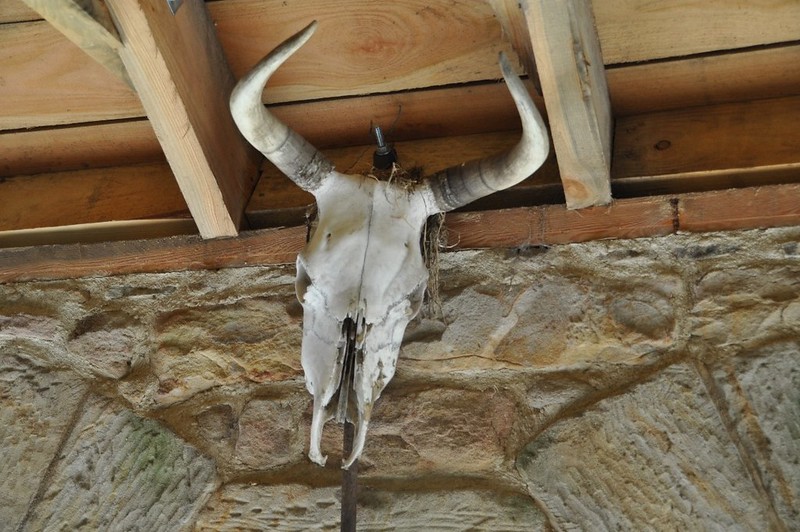 |
| Chillingham skulls with more or less aurochs-like skulls |
From the
first half of the 13th century, British baronial hunting parks
included also cattle for hunting [1]. These cattle also served as ornament,
and the European nobility usually preferred white animals for such a purpose (f.e.
see the Austrian white donkey). While many of the hunting park herds became
strongly influenced by Highland and Longhorn cattle, resulting in the modern
White English Park cattle [1], Chillingham was the only location to retain pure
herds of these hunted cattle, which were probably founded by collecting
medieval husbanded cattle between the 13th and 17th
century [1]. In the 13th
century, a wall around the Chillingham park was built and the cattle were now
protected from Scottish poachers, and they survived in this enclosure until
today. The cattle live in a feral state and were hunted by the nobility just
like Britain’s feral ponies. When they were hunted in earlier days, they were
known to be very aggressive and killed dogs, horses and humans involved in the
hunt.
 |
| Historic engraving by Thomas Bewick, showing the hunt of a bull at Chillingham |
Chillingham
cattle are, like most cattle back in the medieval times were, quite small,
standing only 110 cm at the withers and weighting 300 kg (for bulls, cows are
slightly smaller). However, we know through bone remains that there was a
slight trend to size reduction in the population over the last centuries. Their
body shape is, although comparably slender and firm, domestic in having no
shoulder hump and a rear that is as heavy as the forehand. The udders of the
cows are surprisingly large. Chillingham cattle have large heads (sometimes
also with a long skull), but their body is comparably short-legged and longish.
The horns are mostly upright (100° and more) but aurochs-like in curving
inwards, with slightly upwards-inwards facing tips. Among the skulls on
display, I found some specimen having even more aurochs-like horns than those
in the current population have. Perhaps they stem from the times prior to the
most dramatic bottleneck event in the 1940s. The colour of Chillingham cattle
is interesting: the nasal mucosa are black and cows are coloured creamish (i.e.
darker) on the neck area, what usually is indicative of the wild colour allele
E+ (but the calves are completely white while wild-coloured calves are always born
reddish). Even more surprising is that bulls are slightly darker (grayish) than
the cows, what suggests that they retained some kind of colour dimorphism.
Additionally, they have those numerous small black spots on the face, neck and
shoulder area. I have no clue about the genetic background of the coat colour
in Chillingham cattle. UPDATE: I found out that the colour of Chillingham cattle is caused by the colour-sided allele (Cs) on a base colour that is either black or wild type-coloured. No other breed in the world has the same colour except
White Park cattle. The hair on the neck and face area is very dense and curly
in Chillingham cattle. This “mane” is claimed to serve as a protection of the
bull’s skin during a fight. Some Spanish cattle like the Fighting bull or
Sayaguesa sometimes also show is feature, and it is apparent in single
Oostvaardersplassen bulls as well. Therefore I wonder if aurochs also may have had
it to a certain extent, but this is only speculation.
Chillingham
cattle are dedomesticated in the sense that they are free to breed themselve
and the dominant bulls that cover the cows, and there has never been medical
care or any other form of custody. Nowadays the cattle are supplementary fed
during winter because the area they live on is too small to provide food for
the whole herd, under natural conditions they would migrate. Predators are not
present in the Chillingham Park and I don’t know if they ever were, since it
was a guarded game park of the nobility. The numbers of Chillingham cattle
probably were regulated by food availability, diseases and hunting. Artificial
selection on Chillingham cattle was not totally absent. For example, individuals
with black ears and light noses were selected out. Also, selection probably
played a role in surviving the genetic bottleneck [1] (see below).
When
Chillingham cattle, in spite of being feral for several centuries, still have a
more or less domestic body, upright horns and small size, why is there a trend
in Oostvaardersplassen for Heck cattle developing “wild” body shape and
proportions and aurochs-like horns? I think the key to this question is that the
Oostvaardersplassen cattle descend from a very variable founding population. Evolution
works faster in a variable population than it does in a homogeneous population.
And perhaps the selective pressure for saving energy never was that strong at
Chillingham because of the supplementary feeding (I don’t know when they
started to feed them). Regarding the horns, we should not forget that they are
some kind of aurochs-like in Chillingham cattle. They curve inwards, what is
functionally very advantageous in intraspecific competitions and was the case
in every single aurochs specimen we know. It is possible that the horns of
Chillingham cattle were more aurochs-like prior to the bottleneck event, based
on the skulls which I saw.
The numbers
of Chillingham cattle were documented from 1689 onwards, showing a peak number
of 82 in 1913 before they started to decline [1]. The population crashed in the
severe winter of 1947 to 13 individuals. Not only have they gone through this
genetic bottleneck, but also 300 years of inbreeding, resulting in a highly
uniform nuclear genome [2]. Based on mitochondrial DNA, the whole modern
population descended from a single recent female founder [2]. It is theorized
that Chillingham cattle avoided an inbreeding depression due to purging out
deleterious alleles, which was executed by the wardens during the 19th
century: weak bulls were castrated and weak cows shot for beef before they
could reproduce [1]. Natural selection probably played a role as well, and
nowadays there is no culling or castration anymore. Furthermore, cows allegedly
kill their weak calves.
I was told
that the sex ratio within the herd is 1:1. Having several adult bulls of any
cattle breed on one restricted area can lead to trouble, and indeed Chillingham
bulls often have severe fights, sometimes injure or even kill each other. The
bulls are in constant alertness and have a considerably shorter life span than
the cows (13 years). The often repeated concept of a “king bull” ruling the
herd is probably too simplistic [1]. Chillingham bulls, like bulls of any other
cattle breeds, live in groups of two or three, but are not territorial [1]. Adult
bulls vocalize much, something that I also experienced when I visited the herd.
It is remarkable that there is no rut and they mate all the year round – this
has disadvantages for cow and calf during winter and usually free-roaming
cattle redevelop a natural reproduction cycle. Perhaps this was not the case in
this feral population because of the supplementary feeding in the cold season.
I was told
that the cattle go into the deciduous forest for resting, but interestingly never
go into the conifer forests.
In 2009,
there were 85 individuals at the Chillingham Park, additionally to a reserve herd
in the north-east of Scotland. I hope that in the future there are more
breeding locations in order to conserve these remarkable cattle. It is
uncertain whether they can resist diseases transferred from other cattle breeds
because of their genetic uniformity, but only trying it will show.
The coat
colour of Chillingham cattle as described above is also interesting when
looking at some of the cave paintings in the Lascaux cave. Among aurochs
depicted in the usual colour (red cows, black bulls), there are some individuals
that are drawn only in contours, with prominent black spots on the face, neck
and shoulder area. Could these represent Pleistocene aurochs having the coat
colour of Chillingham cattle?
This is not totally implausible, as a 2011 study
revealed that cave paintings showing white spotted horses were indeed authentic
[4]. There are not any other artistic depictions than the Lascaux paintings
showing such a colour, nor are there any written references of it. This colour
variant, if it existed in wild aurochs, must have persisted at least until the
domestication of taurine cattle 8.500 years BP. I do not consider it likely
that there were aurochs displaying that coat colour, as the evidence for it is
very weak. But it could be worth to investigate by identifying the genes
responsible for the Chillingham colour and trying to find it in Pleistocene and
Holocene aurochs remains, just like Pruvost et al. did in the case of the wild
horse. UPDATE: The colour of Chillingham cattle is caused by the homozygous presence of the Cs allele on a usual base colour. If the colour-sided allele is present only heterozygous, this is the outcome with wild colour as basic colour. I don't consider piebald aurochs to be very likely, as most if not all wild animals are solid-coloured.
That’s a
version of my reconstruction of the Braunschweig aurochs painted in Chillingham
colour:
Literature:
[1] Stephen
J. G. Hall: The white herd of Chillingham.
Journal of the Royal Agricultural Society of England. 1989.
[2] Gavin
Hudson et al.: Unique mitochondrial DNA
in highly inbred feral cattle. 2012.
[3] Albano
Beja-Pereira et al.: The origin of
European cattle: Evidence from modern and ancient DNA. 2006.
[4] Melanie
Pruvost et al.: Genotypes of predomestic
horses match phenotypes painted in Paleolithic works of cave art. 2011.

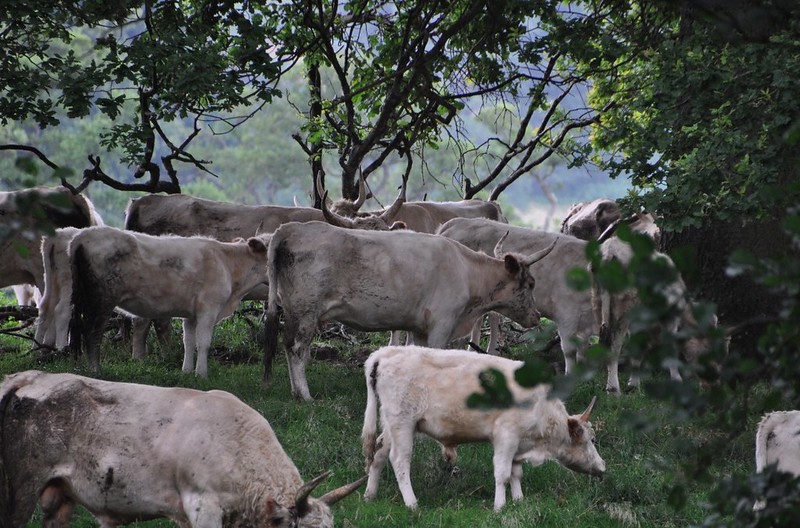
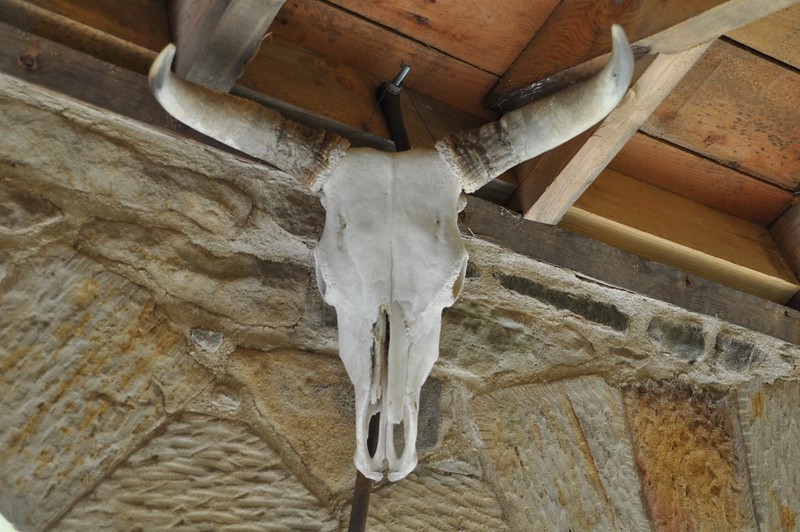
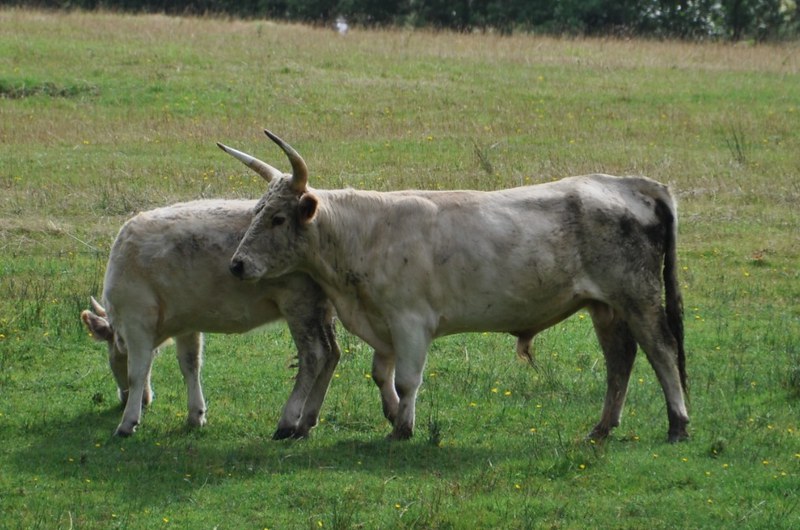
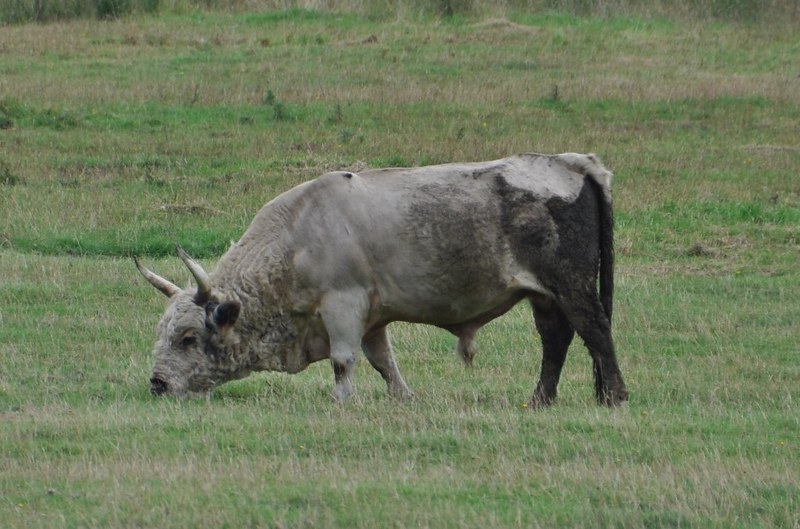
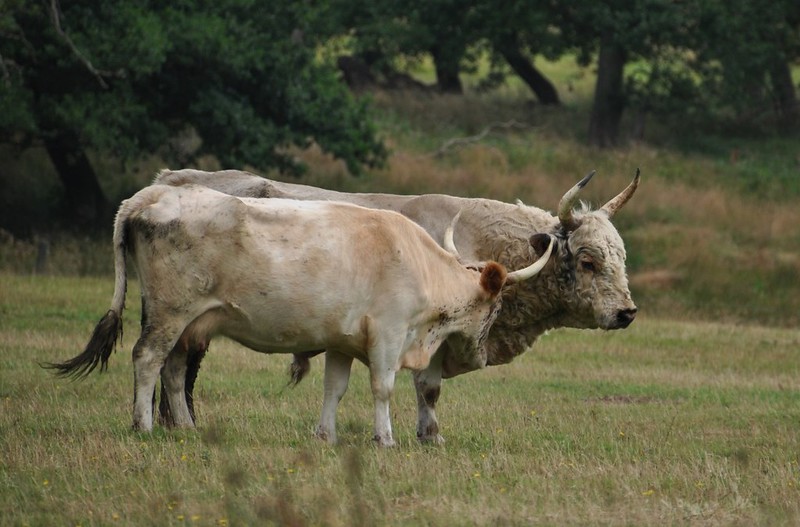
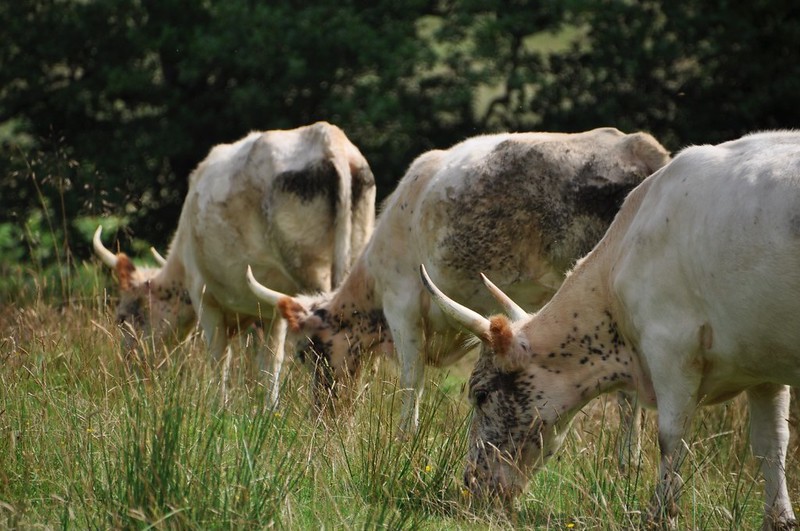
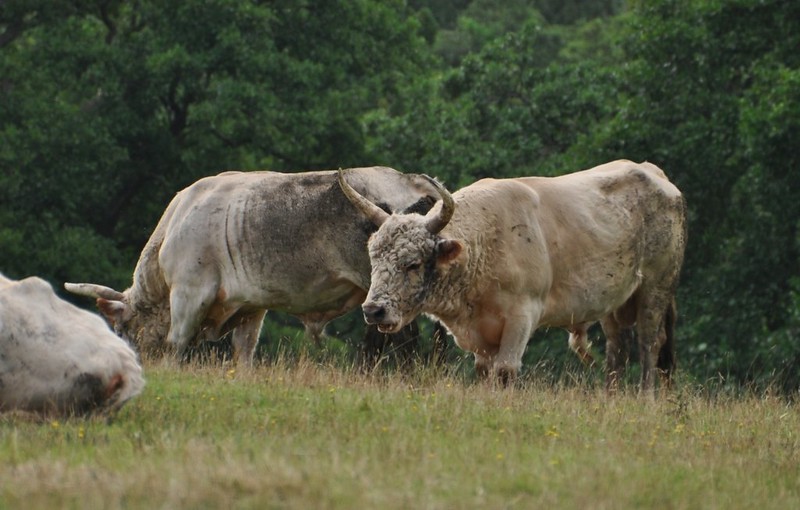
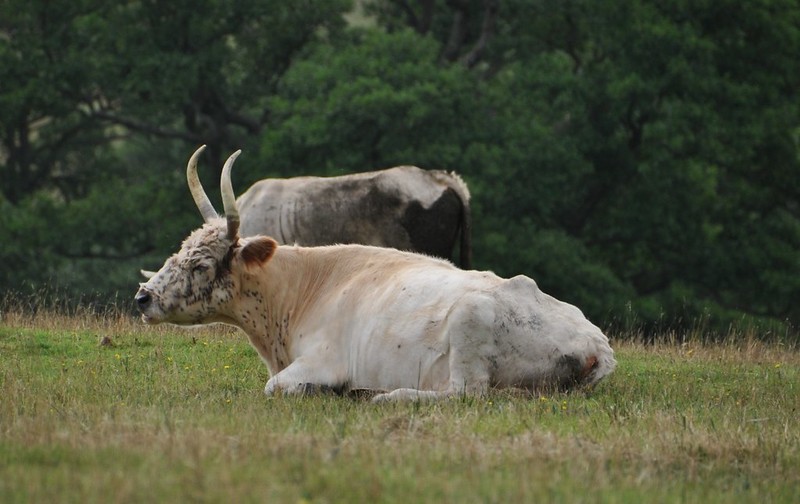

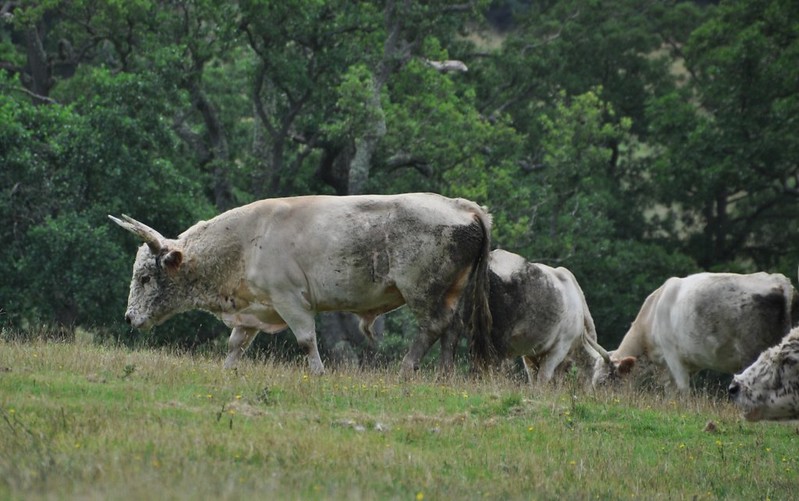

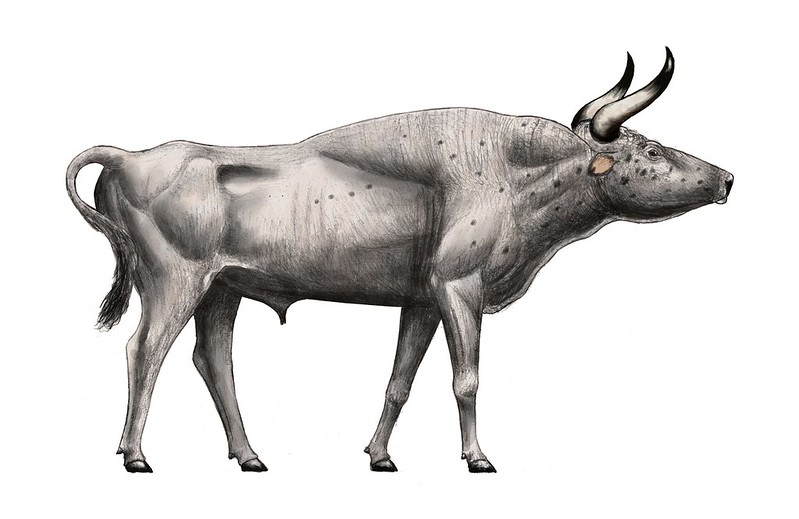
http://www.sciencedaily.com/releases/2011/06/110613211235.htm
ReplyDeleteHere is an interesting article on sciencedaily.com In the article it seems that Chillingham Cattle are year round breeders. The particular problem in the article is that due to climate change they are dropping more calves in winter because of better conception in early spring. I know that in North America Bison are seasonal breeders and don't generally give birth in the winter. This made me wonder about seasonal breeding in cattle in general and I got a hit on a google search- Principles of Cattle Production
By C. J. C. Phillips the google book asserts that both feral cattle and Auroch had seasonal breeding more so than domestic cattle. If that is true, do some primitive breeds retain some seasonal breeding traits? You mention above that Chillingham cattle seem somewhat disappointing in their dedomestication progress compared to Heck cattle on the Oostvaardersplassen preserve and mention the long term inbreeding and a genetic bottleneck sustained recently as possible causes of this failure. This lack of genetic diversity could also mean that the Chillingham cattle may not have access to the genes for seasonal breeding, or enough genetic diversity to adapt to climate change. If that is the case it seems like it would be a reasonable solution to create a sub population by perhaps crossing in a good TaurOs project bull and selecting for historically important traits such as the Cs color allele but still perhaps allowing for some genetic infusion of adaptive traits such as seasonal breeding and horn shape while still retaining most of the material found in the current population. I am also curious about how you think the breeding back of Auroch should interact with existing feral cattle breeds and populations? It seems like if you could release a good TaurOs bull in with some of these existing populations you could create interesting dedomestication experiments. On the other hand you would be permanently altering the populations.
Yes, Chillingham cattle calf all the year round, I thought I mentioned that somewhere in my article. Regarding the reproductive circle of domestic-living primitive cattle, I don't know. Literature is hardly reliable/avaiable on that and sometimes contradicting.
DeleteWhen doing my research on Chillingham cattle, it became obvious to me that this breed isn't actually that feral. I would actually say its a semi-feral landrace; they always were selectively bred in their history, were and are given supplementary food, always lived in a quite confined area and never had to deal with predators.
I don't see the point in mixing them with other cattle or to make an aurochs of them, I think that their exceptional genetic homogeneity is defining for their identity and I guess that neither their owners nor fanciers are in favour of crossbreeding them. If someones wants to use them for breeding-back, it would be better to catch out some individuals and use them in a cross population, but not other way round. But I actually think that the Chillingham isn't any better than other cold-adapted landraces of cattle.
I think the most dedomesticated cattle in Europe are the Betizu; I do have an idea how to use existing feral cattle in breeding-back, I'll describe that in a later post.
Regarding a good Tauros bull: I wouldn't be all to optimistic, it will take quite a lot generations and therefore a lot of time until there is a Tauros bull that is good and stable enough to shift a population from less aurochs-like to very aurochs-like. If Taurus, Tauros, Lidia etc. doesn't matter that much, the main issue is what features the animals contribute to the population.
Polled British White Cattle . . . . the polled ancient Park cattle of Medieval times, and Immortalized in Ancient Celtic Myth and Law many thousands of years ago.
ReplyDelete“Early accounts have suggested that hornless or polled cattle were introduced to Ireland and Britain from Scandinavia by Viking settlers (Wilson 1909). However, this theory is contradicted by the presence of polled cattle in the Irish archaeological record prior to the appearance of the Vikings (McCormick 1987).” DNA analyas of cattle from Viking Dublin 1999, D. E.MacHugh and others, P. 100.The purpose of this project was to explore the ancient breed history of Britain’s Park Cattle and clarify the relationship between the ancient horned White Park of today and the ancient polled White Park of today (now referred to as British White). In 1918 the Park Cattle Society was formed in the United Kingdom and a herd book formally established which recorded both horned and polled ancient white park cattle of both black and red points. In 1946, breeders of ancient polled Park Cattle separated from the Park Cattle Society and formed the British White Cattle Society – thereafter the ‘polled’ park cattle were known by the distinguishing breed name – British White.
Britain’s White Park Cattle Society quite oddly declares no relationship to the polled British White, yet the information currently available in essays and articles on the polled British White and the horned White Park reflects much of the same lore and legend.
DeleteThey share this lore and legend because both varieties of park cattle were present in the British Isles since ‘time immemorial’. In Wild, White Cattle” (p.36) by James Edmund Harting (c.1880), it is clear that at the onset of the Middle Ages there were polled herds, horned herds with a variety of shape and length, and herds with both red and black color points. The distinguishing trait today that separates the two varieties is the presence of horns, and secondary to horns would be the disposition of the animal, and those same traits have existed for hundreds of years — the difference today is our 21st century need to peg this wonderful bovine into two distinct breeds. It’s interesting to compare the Rare Breeds Survival Trust’s (a UK charity supported national conservation society) descriptions of the two breeds. It strikes one that they are careful not to step on the toes of the horned White Park Cattle Society, likely because one of their most influential members has strong connections with the White Park Cattle Society. Conspicuously absent is any mention in the White Park breed description of the original founding Park Cattle Society that dates back to 1918 that encompassed all white park cattle, polled or horned, within the United Kingdom.
As well, there is no mention given to the introgression of English Longhorn and Welsh Black genetics into horned White Park herds; and certainly no mention that prior to the 1940’s owners of horned herds made use of polled white park (British White) bulls to improve their herds. The following is an excerpt from the Conclusion section of Jessica Hemmings’ excellent 2002 research article which would appear to lay to rest the claims of horned White Park Cattle, whether docile or wild, of being of ancient aurochsen origin which we are to believe makes them a breed of greater antiquity than that of the polled British White:
Delete“. . . .The public literature distributed by the Chillingham Wild Cattle Association deliberately fosters this sense of mystery, as does the Association’s reluctance to accept the findings of recent zoological studies which indicate that the animals (Chillingham park cattle) are the feral descendants of ordinary domestic stock. Nobody claims that they come from the fairy mounds any longer, but arguing that they are the direct descendants of “the gigantic wild white bull of Caesar’s time, and of the monstrous bovine wonders of the Palaeolithic and neolithic ages” (Wallace 1907, 29) seems thematically similar. Where the origin is obscure, it is easy to imagine it to be remarkable. . .”
Within the existing horned White Park herds in the UK, there are apparently animals of both wild and tame disposition. However, the horned Chillingham herd of White Park cattle is considered to be representative of the true feral (wild) white park animal, and DNA testing is said to show these Chillingham animals as distinct from any other European breed. However, per Hemmings 2002 research:
Delete“. . .Although both the late president and the patron have quoted genetic work done on the cattle to support their arguments, the zoological reports in fact make it quite clear that the Chillingham herd does not have any special relationship to the aurochs whatsoever (Hall 1982-3, 96; 1991, 540).”
The Chillingham cattle continue to live in their native habitat and the introduction of new blood is said to be minimal to non-existent. Unfortunately, many historians and breeders key in on this falsely supported DNA report and presume that all horned white park cattle are proven distinct from the polled British White. I believe this is an error of enormous consequence perpetuated by Britain’s White Park Cattle Society for their own disserving purposes that will one day be corrected. There is no public data that identifies the lineage of the British White animals that were used for the basis of these tests, but most assuredly in my opinion the horned White Park animal (s) that was tested was a cow or bull of the most exceedingly closed Chillingham genetics and bears no relationship to the fat and docile appearing horned White Park animals to be found more commonly in Britain, which even a novice can ascertain as having a distinct kinship with Britain’s and the USA’s polled British White cattle.
“Although there is strong evidence that the White Galloway and White Park patterns are due to the tyrosinase gene, the mutation does not occur in the coding portion of the gene and therefore no DNA test has been developed. This temperature sensitive expression of pigment, like that of the Siamese cat, is inherited as a dominant. If a rancher breeds 7 non-white cows and obtains 7 white calves, there is a 99% chance that the sire is homozygous for this trait.” DNA Tests for Cattle – Dr. Sheila Schmutz
Delete. . . .of the polled British White (pre 1946 White Park) markings it could be easily surmised that at some point in time the British White was bred into the Galloway, and I would instinctively surmise this occurred well before the modern days of 1960. I would have thought the odd white Galloway would be found more closely linked to the British White judging from simply the look of these ancient polled cattle and their docile nature and the dominance of the white park markings once introduced into a breed, this White Galloway breeder appears to concur.
“As can be clearly seen, the breeders of these cattle were engaged in a continual struggle to maintain numbers, and from time to time the blood of other breeds was introduced in order to avoid problems associated with in-breeding and to achieve the desired type. (The article on page 7 of the 1998 British White Breed Journal by Mr J Cator gives a full account of these outside sources used between 1840 and 1918 in the Woodbastwick herd).” (source: British White Cattle Society – UK)
The polled variety of the white park cattle was considered superior by this elder cattleman of the UK in the early 20th century. The excellence “since time immemorial” of the polled white park cattle referred to by this gentleman continues today. . .
Sir Claud Alexander, owner of the Faygate herd, writing in the 1912 “Amateur Menagerie Club” Year Book says:”I would, however, strongly advise anyone who may think of forming a herd to go to the polled variety for his foundation stock, for they have been kept from time immemorial for their milk and beef producing qualities, and right well do they justify their existence… The Somerford cows are excellent milkers and one of mine averages five gallons a day when in full profit. In addition to this they are big heavy beasts and give a good return from the butcher when their milking days are over…. Mr Quinton Gurney’s herd at Northrepps Hall is a thoroughly practical one, for on it devolves the task of keeping the town of Cromer supplied with milk. At Woodbastwick too, some grand milkers are to be found, and here great attention is paid to beef producing powers, as the records of the local fat stock shows frequently testify… If anyone who reads these notes and feels inclined to form a herd will communicate with me, I shall be pleased to supply any information that may be required.”
What I find most interesting is the casual inference that the polled variety has better milk and beef producing qualities and has from “time immemorial”. The domesticated white park cattle (British White) from the days of the Druids should have better milk and beef producing qualities than the wild variety of the horned Ancient White Park.
DeleteA few years after the excerpt above was printed, the Park Cattle Society was formed in the UK in 1918, which encompassed both horned and polled examples of the breed. In 1946 the group split and the polled white “Park Cattle” animal became formally known as a British White and the British White Cattle Society in the UK was established. Through their efforts the polled British White has risen from numbers so low as to be listed a rare breed, to it’s status now as a minority breed. Their numbers will continue to grow as this beautiful, docile animal becomes more broadly known across the world as the breed that delivers all that an owner can wish for in health, longevity, fertility, milk, and beef.
.
Extract FROM JOHN O’GROATS TO LAND’S END, SEVENTH WEEK’S JOURNEY, Oct. 3 to Nov. 5 1871. “We now bade good-bye to the River Dove, leaving it to carry its share of the Pennine Range waters to the Trent, and walked up the hill leading out of the town towards Abbots Bromley. We soon reached a lonely and densely wooded country with Bagot’s Wood to the left, containing trees of enormous age and size, remnants of the original forest of Needwood, while to the right was Chartley Park, embracing about a thousand acres of land enclosed from the same forest by the Earl of Derby, about the year 1248. In this park was still to be seen the famous herd of wild cattle, whose ancestors were known to have been driven into the park when it was enclosed. These animals resisted being handled by men, and arranged themselves in a semi-circle on the approach of an intruder. The cattle were perfectly white, excepting their extremities, their ears, muzzles, and hoofs being black, and their long spreading horns were also tipped with black. Chartley was granted by William Rufus to Hugh Lupus, first Earl of Chester, whose descendant, Ranulph, a Crusader, on his return from the Holy War, built Beeston Castle in Cheshire, with protecting walls and towers, after the model of those at Constantinople. He also built the Castle at Chartley about the same period, A.D. 1220, remarkable as having been the last place of imprisonment for the unfortunate Mary Queen of Scots, as she was taken from there in 1586 to be executed at Fotheringhay.”
It's interesting that you find the Betizu cattle the most de-domesticated race. I thought that title would have gone to one or more of the Lidia lineages? They are kept in a feral state are they not? Bulls being allowed to roam free and fight and the winner being chosen as a breeding bull. Did you ever watch this film? I think you might find it interesting if you haven't.
ReplyDeletehttps://www.youtube.com/watch?v=Fxdw7CCK7Vw